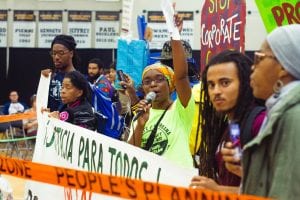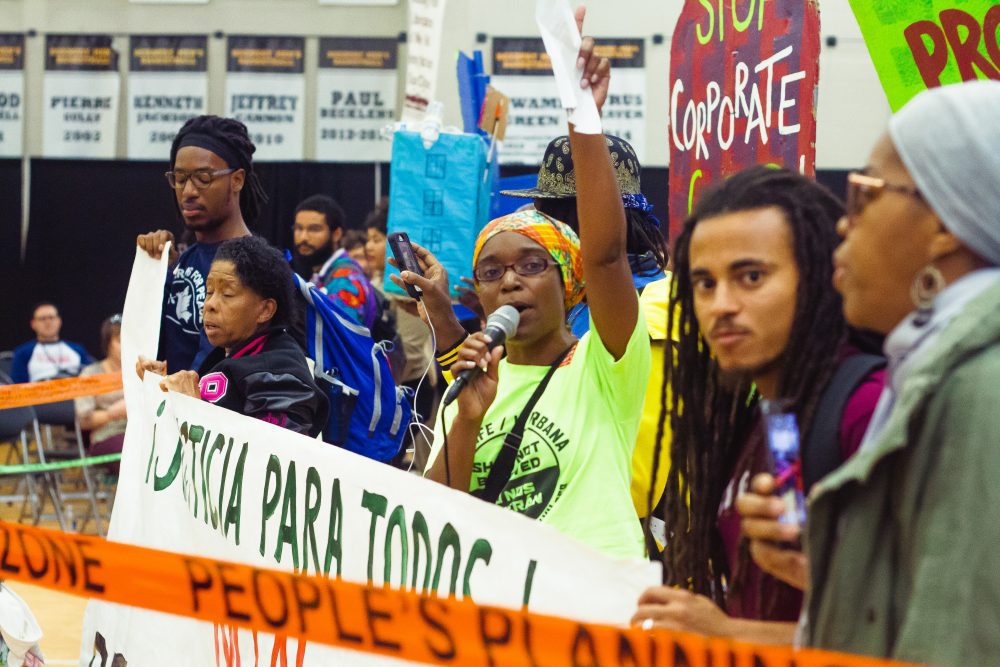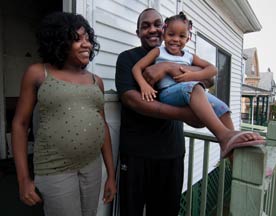
Lisa Owens, executive director of the housing justice organization City Life/Vida Urbana, led an interruption of the YIMBYtown national conference, declaring that the people most impacted by displacement must lead the solutions. Photo courtesy of City Life/Vida Urbana
This past August, a broad new coalition in Boston formed to plan a massive march against Bank of America and other corporate targets on Sept. 30. A smaller group also began organizing to occupy a vacant foreclosed building and lot on Oct. 1. Both these actions were timed to coincide with the national Right to the City Coalition Assembly in Boston, and both involved carefully developed union-community cooperation.
Then, on Sept. 17, Wall Street was “occupied” and planning began for an occupation in Boston also to start on September 30. City Life/Vida Urbana and other organizations involved in the preexisting plans had members at the Occupy Boston general assemblies. We urged that the initial occupation be put off a week to avoid competing with the Right to the City message.
Despite that effort, the occupation of Dewey Square in Boston went ahead on September 30. It took place a few moments after 3,000 people converged on Bank of America, accompanied by civil disobedience and 24 arrests. That march was amazingly diverse as the bases of the sponsoring organizations turned out in force. Nevertheless, the press interpreted the action as part of Occupy.
The next day, hundreds showed up on Fowler Street in Dorchester to occupy a vacant foreclosed building and construct raised gardens in a vacant lot. Again, it was seen as an Occupy event.
These were early misunderstandings, but an important political issue also emerged. City Life is a “base-building” group. We seek to organize those directly affected by a problem — currently the mortgage/foreclosure crisis. We seek to build a movement where the people affected are the ones in leadership.
City Life is a “radical” organization; however, to us, a vigil with no arrests but participation from those affected is more “radical” than civil disobedience where those affected are not participating. Many in Occupy agree with this interpretation, but much of the debate in and around Occupy results from differences over this historic question of left organizing.
In practice, City Life has helped to build a radical movement around the recent crisis that is led by those affected and does, in fact, engage in a lot of civil disobedience and an amazing pace of direct action. This has included both eviction blockades (32 through November 2011) and building occupations.
In October, City Life began inviting Occupy members to visit our weekly meetings. Several of our members were regulars at the encampment. We took large delegations to MassUniting marches organized out of Dewey Square and to the Occupy the Hood event in Dudley. Occupy members came to several of our rallies and actions. We issued a national statement defending the right of communities to occupy vacant foreclosed buildings in their midst, but we urged that those tactics be used to support a base-building strategy.
These interactions gradually overcame some skepticism on our part. Our initial reaction included awareness of the tendency of the media to cover events organized by those with relative privilege but not events organized by those directly oppressed.
On the other hand, we quickly began to understand that Occupy was a political moment triggered by the encampments but carrying implications far beyond that. As the head of MassUniting commented, “You can build a beautiful ship, but you can’t create the wind. Occupy is the wind.” City Life had already had extensive discussions in our Leadership Team meetings about Egypt and Tahrir Square. Occupy was the U.S. extension of that movement.
And so, when the national Occupy movement (in partnership with many community organizations) turned to these tactics in December as the next stage of their struggle, City Life built upon its ongoing conversations with Occupy members in order to respond. City Life and a handful of Occupy members set up small group discussions to develop joint work. Our intent is to relate to a group of Occupiers who retain their organizational identity but respect the discipline of City Life’s base.
Our first collaborations occurred on December 16 and 19. The first was a press conference at the building City Life occupied on Fowler Street. City Life presented members who had gotten their homes back at real value, as well as the tenant moving into Fowler Street. An Occupy member made a strong statement about planning joint work with City Life.
On Dec. 19, Occupy members choreographed a skit at a demonstration in front of HUD’s regional office in Boston, protesting HUD-mandated evictions in foreclosed buildings. The Occupy skit used a Star Wars theme to chase away the evil Count Bankula (City Life’s puppet).
Everyone was pleased by these first collaborations and is looking forward to further struggles in 2012.






Comments